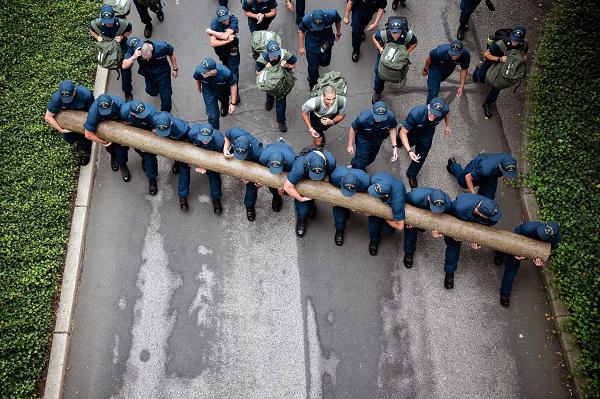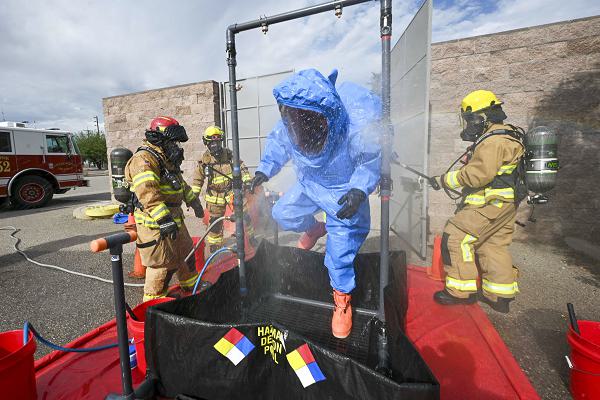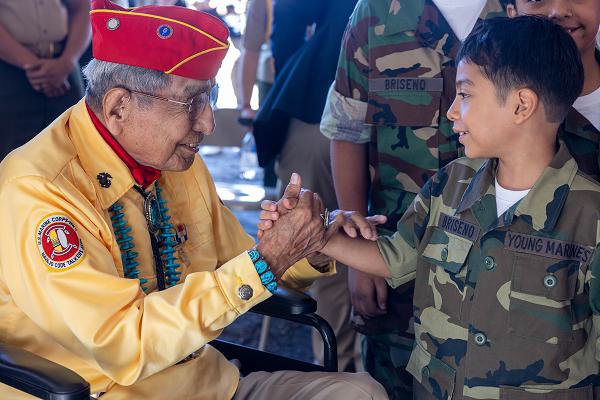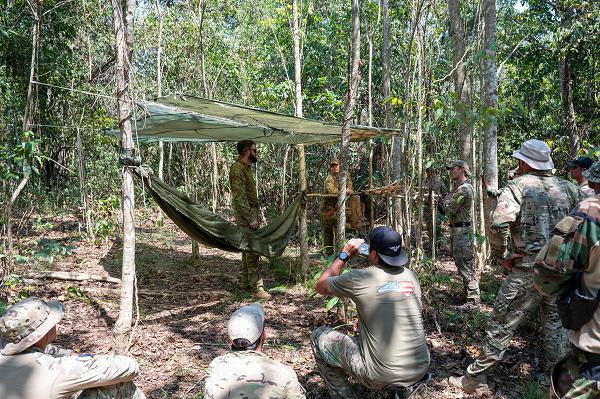- Details
- Hits: 1508

New London, Connecticut. (September 10, 2024): There is a long-standing myth that Coast Guard training is the easiest of the services, nothing could be further from the truth. In this photo by Petty Officer 3rd Class Matt Thieme, cadets carry a log uphill during sea trials, a daylong series of physical and mental challenges to mark the end of their summer training program. Obtaining a commission in the U.S. Coast Guard is no easy feat, both physically and mentally, and is one of the toughest programs in the military services.
The Academy was formed as the U.S. Revenue Cutter School of Instruction-Underway in 1876 and officially became the Coast Guard in 1915. the Coast Guard Academy's mission is to “graduate young men and women with sound bodies, stout hearts, and alert minds, with a liking for the sea and its lore, and with that high sense of honor, loyalty, and obedience.” The Academy also stresses initiative, leadership, and officers who are well-grounded in seamanship, the sciences, and have a strong resolve to serve their country.
Each year, about a thousand students attend the school to study one of nine majors including four types of engineering degrees that involve programs in naval architecture and marine science. In a typical Academy class, 88% played varsity sports in high school, 41% had a parent who served in the military, and 78% planned to pursue a technical major.
- Details
- Hits: 9897

Marine Corps Base Camp Pendleton, California. (September 14, 2024): The internet is flooded with videos of military drill instructors barking orders at frightened recruits and that has been damaging to recruiting. In this photo by Corporal Sarah Grawcock, Marine Sergeant Alberto Ochoa, a drill instructor with the 2nd Recruit Training Battalion, corrects a recruit during Basic Training… and a certain amount of yelling is involved. What is the purpose of this tactic and is it an essential part of infantry combat training?
Parents are reporting their kids are interested in joining the military but videos they have seen on YouTube leave them intimidated by the harsh rhetoric. Military officials argue the videos do not provide the proper context nor the functional reasons for why issuing orders at the top of your lungs saves lives in combat.
Take the first day of Basic, for example, where some two hundred confused and disoriented civilians pour off a bus who are totally unfamiliar with the military. Within five minutes of arrival, drill instructors teach this mob how to listen and learn, respond to orders, stand in formation, and move as a unit. Yelling orders may seem like chaos as drill sergeants pounce on recruits barking orders, but it is a carefully crafted performance. Every move an instructor makes is choreographed to shape raw recruits into the ways of military life. None of what a Drill Instructor does is arbitrary.
- Details
- Hits: 1804

Davis-Monthan Air Force Base, Arizona. (September 5, 2024): It is an ugly fact of life that America’s enemies will not hesitate to use chemical, biological, or even nuclear weapons against our troops. In this photo by Staff Sergeant Christina Russo, Senior Airman Ronald Cataldom is being decontaminated during a simulated chemical, biological, radiological, and nuclear attack. The exercise was made more real by “exposing subjects to an unidentified substance” requiring Airmen to set up a decontamination zone to treat the “victims” quickly and effectively.
Decontamination is the cleaning process conducted to prevent a wounded person contaminated with chemical, biological, or nuclear agents from infecting other wounded troops or the personnel who intervene. In general, decontamination is divided into three types: mechanical, physical, and chemical.
Nuclear agents are materials released by nuclear fission or through the release of other radioactive material, often called dirty bombs, which has the potential to affect human health. The procedure in the event of radiological attack requires two decontamination cycles with a radiation survey after each cycle. Warm water and a neutral soap are mixed to create an emulsifying fluid that dissolves the contamination while also directing the water away from the patient.
Biological agents are formulated to cause infection or disease, and these hazards include epidemics, animal plagues, and insect infestations. Treatment for bio-hazards involves using alcohols, chlorine dioxide, and hydrogen peroxide to kill infectious organisms.
- Details
- Hits: 1401

Window Rock, Arizona. (September 1, 2024): In this photo by Lance Corporal Erica Stanke, a member of the glorious history of the Marine Corps spends a day with Young Marines who represent the future of this heralded institution. The past was represented by Corporal Peter Macdonald, a Navajo Code Talker veteran who used his native language skills to provide an unbreakable military code during World War II. Joining them in this annual event were members of the Young Marines Program, a national non-profit 501c (3) youth education and service program for children, aged eight through high school that promotes the mental, moral, and physical development of its members.
During the height of the war in the Pacific, America needed an unbreakable code to communicate their operational plans without revealing them to the enemy. They found the perfect solution, the Navajo Nation. The Marines selected 29 Navajo men, the Navajo Code Talkers, who created a code based on the complex, unwritten Navajo language.
The code assigned a Navajo word to key military phrases that enabled the Code Talkers to translate three lines of English in 20 seconds, not 30 minutes as was common with existing code-breaking machines. During the nearly month-long battle for Iwo Jima, for example, six Navajo Code Talker Marines successfully transmitted more than eight hundred messages without error. The Code Talkers went on to participate in every major Marine operation in the Pacific theater, giving the U.S. a critical advantage throughout the war. At the end of the war, the Navajo Code remained unbroken.
- Details
- Hits: 1372

Paris, France. (September 8, 2024): If any one person personifies America’s willingness to fight and never give up, it is Sergeant First Class Elizabeth Marks. In this photo by Major Nathaniel Garcia, SFC Marks, an elite swimmer, joins her comrades after winning the Silver Medal at the Paris 2024 Paralympic Summer Games. Marks won Team USA its first medal of the games with an incredible performance in the women's 50-meter freestyle.
Marks is the daughter of James Marks, a U.S. Marine veteran who served during the Vietnam War, and she attended a military style high school graduating at sixteen. After attending community college in Arizona, Marks joined the Army in July 2008 at seventeen where she trained as a combat medic. During a deployment to Iraq, she was severely injured, and, after a long and painful recovery, she was fitted with a prosthetic leg.
Part of her recovery therapy involved extensive time in swimming pools that soon became her sanctuary. She developed into a world class para-swimmer, yet adversity struck again when she contracted a mysterious lung disease. Unable to breathe, Marks was placed into a medically induced coma and attached to a lung machine. She nearly died.
Despite this, Marks competed in the 2014 Invictus Games in London at the invitation of Britain’s Prince Harry. She won the Gold and, at the awards ceremony, dedicated her medal to the hospital staff that saved her life. In the 2021 games in Tokyo, Marks became the Army World Class Athlete Program’s most decorated athlete, breaking the all-time world mark in the women’s 100-meter backstroke. She achieved this feat despite having her left leg amputated in 2017 and continuing visual and breathing problems. She left Japan with a Gold, Silver, and Bronze medal.
- Details
- Hits: 1289

Port Moresby, Papua New Guinea. (September 1, 2024): What would you do if you found yourself stranded in the wilderness and in need of shelter? In this photo by Airman 1st Class Carson Jeney, Royal Australian Air Force Corporal Anthony Ross, an instructor with the Australian Defense Force Combat Survival School, demonstrates a variety of well-built shelters used in survival scenarios. The training involved the U.S. Air Force and the Papua New Guinea Defense Force during exercise Pacific Angel 24, an annual exercise to share knowledge of survival, evasion, resistance, and escape techniques.
A typical scenario involved downed pilots who suddenly find themselves in an unfamiliar wilderness where they are forced to survive with minimal gear or resources. The number one priority in such a situation is to seek adequate shelter from the elements while hiding your presence from the enemy.
Combat survival schools advise seeking out natural features like caves or rock overhangs can be easily made into good survival shelters. It is not advisable, according to these experts, to build a fire inside a cave because it may cause rocks overhead to dislodge and possible kill you. Other natural shelters include fallen trees that create a canopy to block the wind and rain. Finding a ready-made survival shelter saves a lot of time and energy which allows more time to seek food and water.
If no caves or overhangs are available, there are a couple of handy types of structures that can be quickly assembled using natural materials such as branches, leaves, moss, or large leafed plants. It is important that your structure “gets you off the ground” above possible flooding. This is why it is important to never build on low ground or close to a body of water. Other important considerations are the direction of the wind and the sun’s location.


